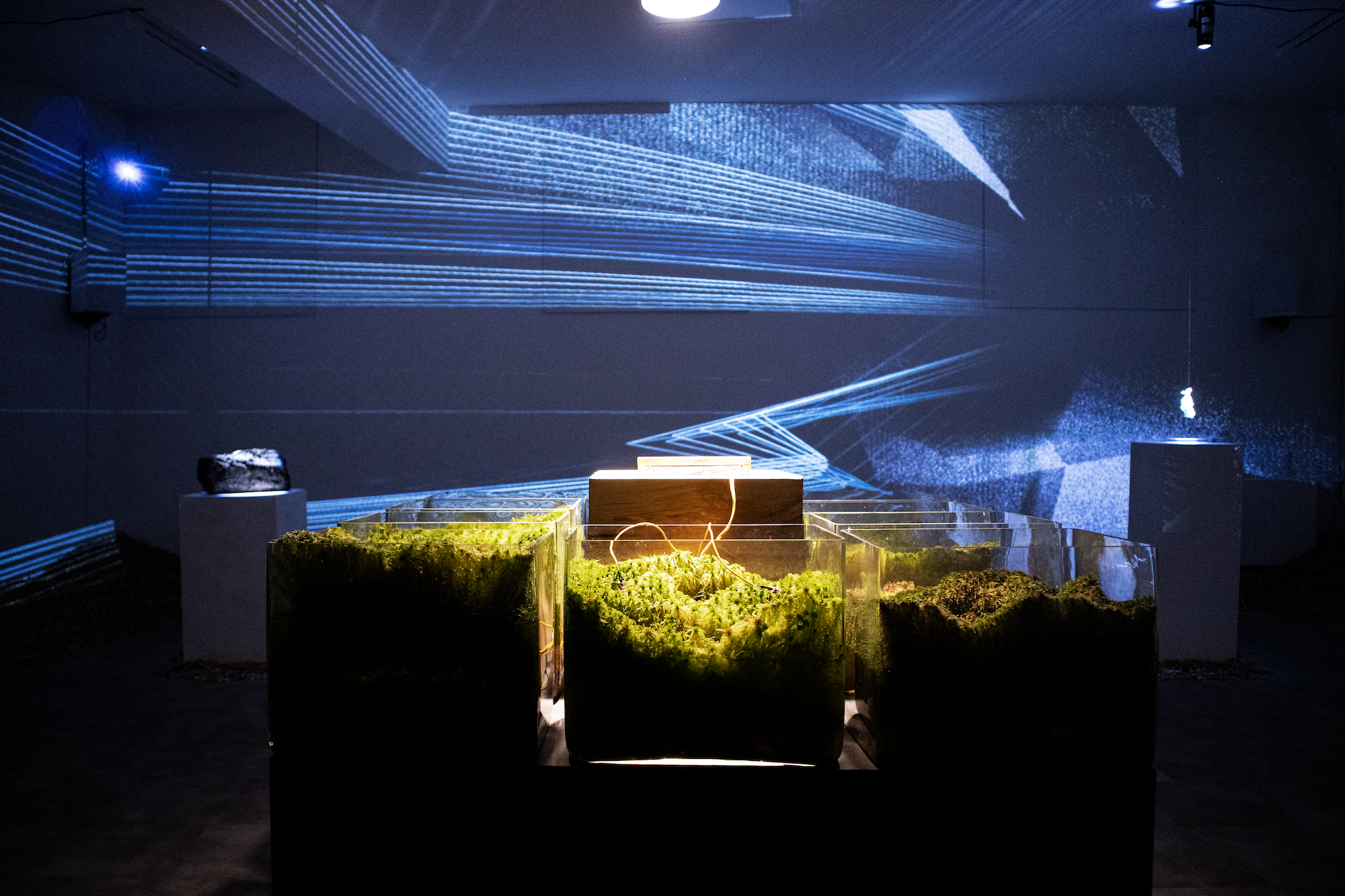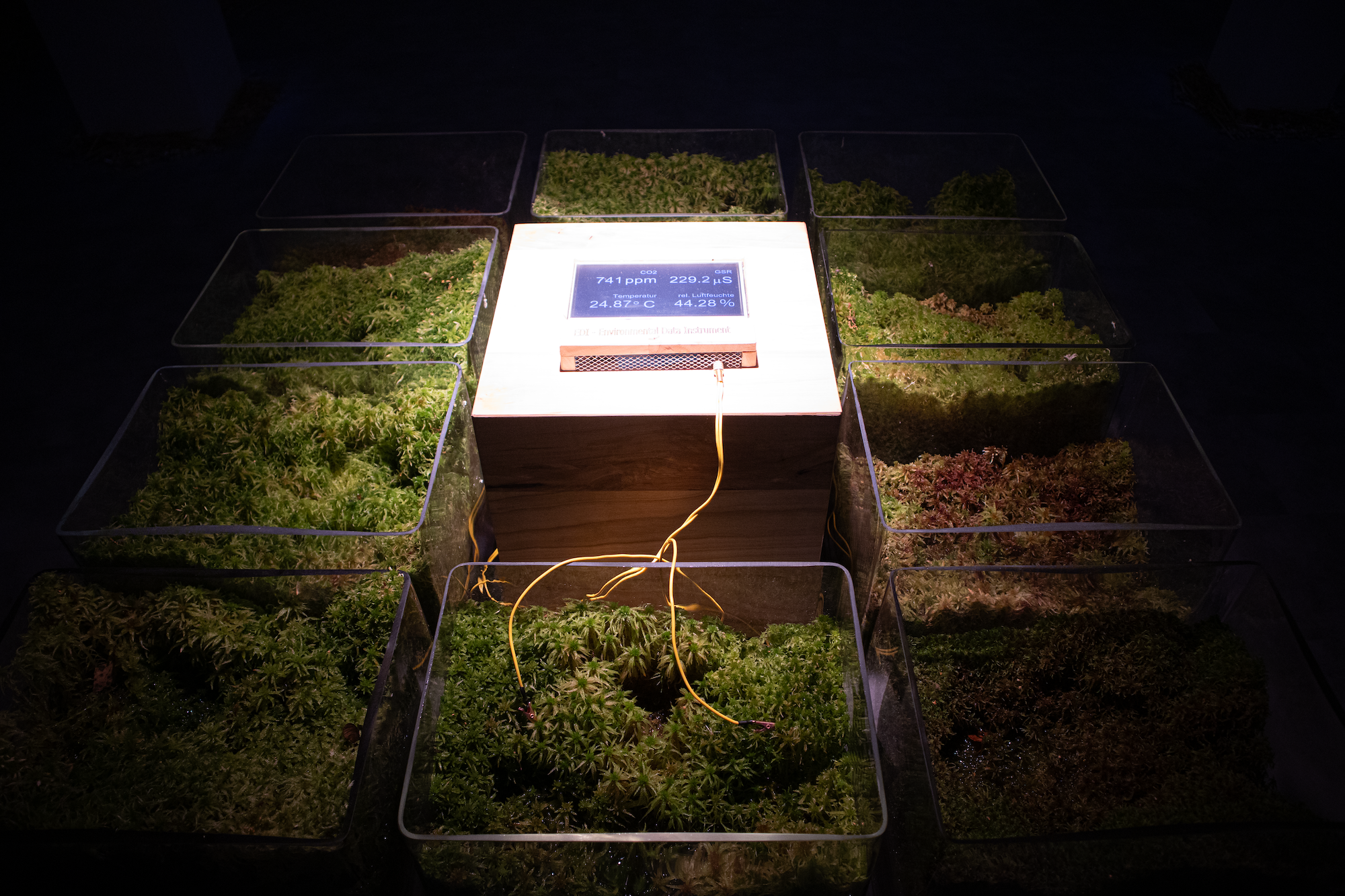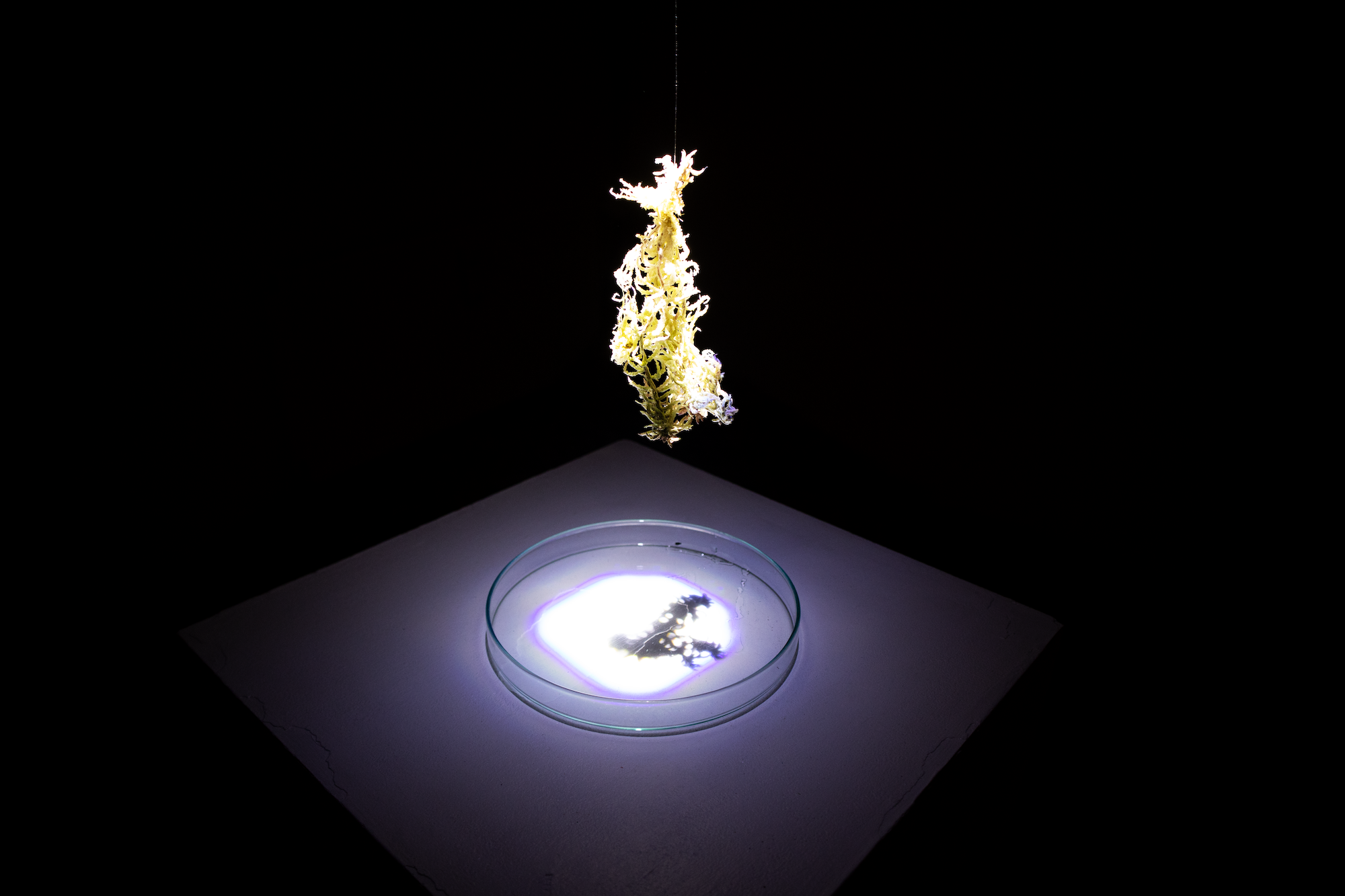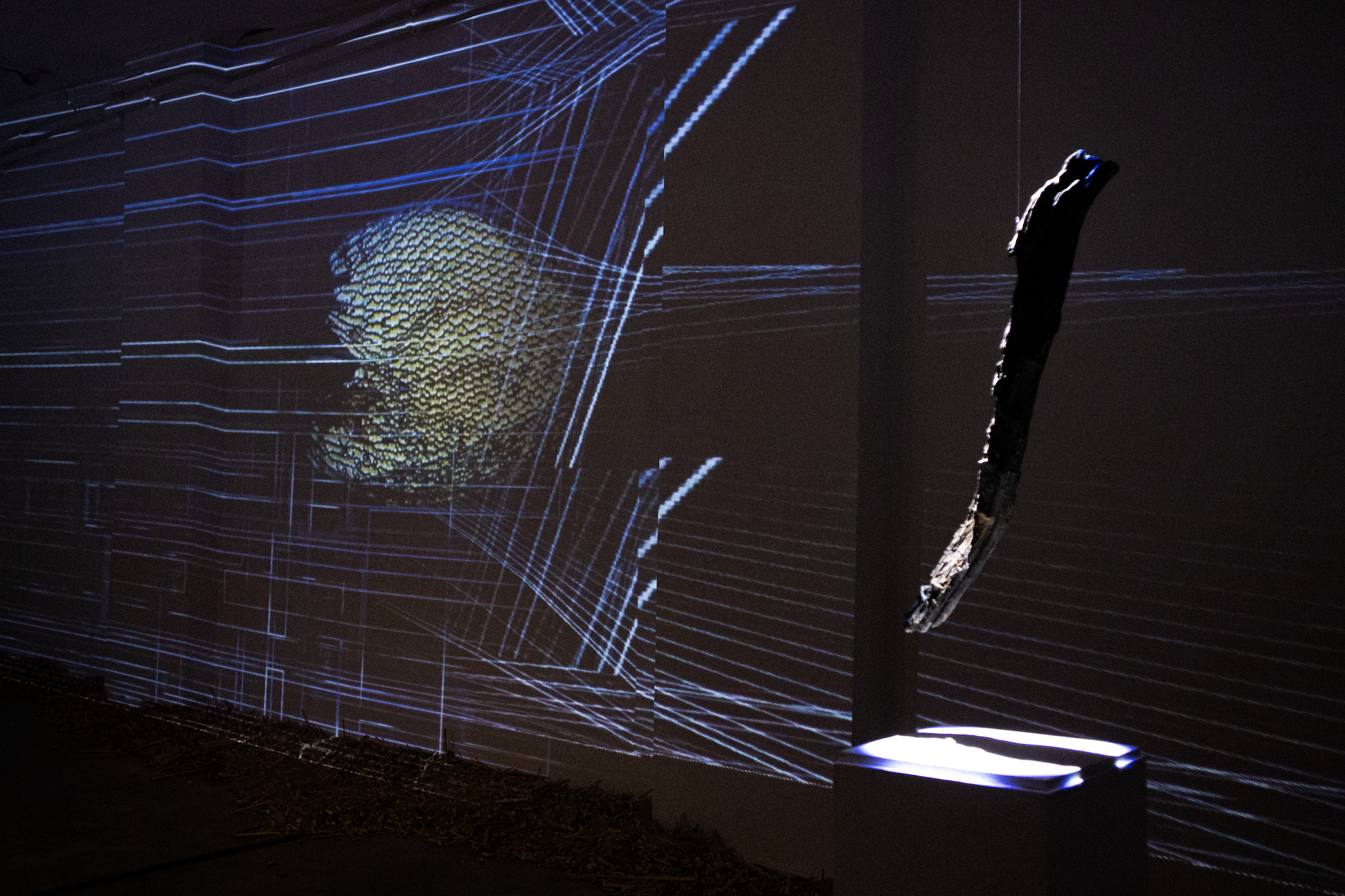





Ein:Fluss:Raum:Moor
Installativer Klangraum
30.10-8.12.2024, Spielhalle Kunst, Greifswald
Caspar David Friedrich Jubiläum 2024
Für EIN:FLUSS:RAUM:MOOR wurden Bodenmikrophone in zwei umliegende Greifswalder Moore (Kieshofer Moor, Karrendorfer Wiesen vor Koos) eingebracht, die unterschiedliche, sehr individuelle Klangbilder zeigen. Grundlage für die Bilder der Videoinstallation sind Mikroskopaufnahmen von Torfmoosen (Sphagnum). Sensormessungen in den Moorkörpern und den dort freigesetzten Treibhausgasen, wie Kohlendioxid und Methan, interagieren mit den Mikrofon- und Mikroskopaufnahmen und lösen formgebende Impulse aus. Auf zwei jeweils gegenüberliegenden Lautsprechern treten zwei Kompositionen aus den beiden Mooren in Bezug. Diese Kompositionen sind jeweils in vier Phasen aufgeteilt: Entwicklung, Manipulation, Adaption und Integration. In der Mitte des Ausstellungsraums werden durch Sensoren in Echtzeit CO2-, Temperatur- und GSR-Daten der Moorvegetation erhoben und bilden den Puls des Geschehens. Das Publikum beeinflusst durch seine Anwesenheit im Raum zusammen mit den Moorpflanzen den Klang und das Tempo der Installation. Die Raumdaten sind am hierfür entwickelten EDI (Environmental Data Instrument) in der Mitte der Moorkörper ablesbar. In den Raumecken werden Fundstücke und Vegetation aus dem Moor skulptural eingebracht. In der organischen Verbindung dieser Elemente ensteht ein sich kontinuierlich veränderndes, begehbares Bild, das zum Forschen einlädt, und Umwelt zur Mitwelt macht.
Werk-Genese: Caspar David Friedrich als Inspirationsquelle
In der Mehrheit der Bilder von Caspar David Friedrich finden sich drei Bereiche: fester Boden im Vordergrund, ein Übergangs- und Konvergenzraum im Mittelgrund und eine nach oben strebende Öffnung zum Metaphysischen. Moorland verkörperte in seiner Ungreifbarkeit für Caspar David Friedrich diesen Übergangsraum zwischen Himmel und Erde, Bereiche der Haltlosigkeit. Dieses Miteinander von Greif- und Ungreifbarem, die Mehrdeutigkeit und Transzendenz der Dinge bilden die Grundlage der Arbeit von MONAS. Die kulturellen Umschwünge, zunächst über Jahrhunderte Moore zu entwässern und diese jetzt wieder zu vernässen, wird zum Synonym für einen lebensnotwendigen Paradigmenwechsel. Entsprechend werden in der Arbeit des MONAS Collective wissenschaftliche Erkenntnisse aus der künstlerischen Perspektive betrachtet, lösen gegenseitige Impulse aus und eröffnen neue Denkräume. Es entsteht ein Organismus aus Klang, Bild und Skulptur.
For EIN:FLUSS:RAUM:MOOR, ground microphones were placed in two surrounding moors in Greifswald (Kieshofer Moor, Karrendorfer Wiesen vor Koos), which show different, very individual sound images. The images in the video installation are based on microscope images of peat mosses (Sphagnum). Sensor measurements in the moor bodies and the greenhouse gases released there, such as carbon dioxide and methane, interact with the microphone and microscope recordings and trigger formative impulses. Two compositions from the two moors relate to each other on two loudspeakers facing each other. These compositions are each divided into four phases: development, manipulation, adaptation and integration. In the middle of the exhibition space, sensors collect CO2, temperature and GSR data from the moor vegetation in real time and form the pulse of the action. The audience influences the sound and tempo of the installation through their presence in the room, together with the moor plants. The spatial data can be read on the EDI (Environmental Data Instrument) developed for this purpose in the middle of the moor bodies. In the corners of the room, found objects and vegetation from the moor are sculpturally incorporated. The organic combination of these elements creates a continuously changing, walkable image that invites research and turns the environment into a shared world.
Genesis: Caspar David Friedrich as a source of inspiration
In the majority of Caspar David Friedrich's pictures there are three areas: solid ground in the foreground, a transition and convergence space in the middle ground and an upward-striving opening to the metaphysical. For Caspar David Friedrich, moorland, in its intangibility, embodied this transitional space between heaven and earth, areas of instability. This coexistence of the tangible and the intangible, the ambiguity and transcendence of things form the basis of MONAS's work. The cultural changes, first draining moors for centuries and now rewetting them, have become synonymous with a vital paradigm shift. Accordingly, in the work of the MONAS Collective, scientific findings are viewed from an artistic perspective, triggering mutual impulses and opening up new spaces for thought. An organism of sound, image and sculpture is created.
Kurt Holzkämper: Klangkomposition, künstlerische Leitung
Laurenz Theinert: Projektionen
Phillip Staffa: Objekte und Raumkonzeption
Prof. Dr. Hubert Wiggering: Wissenschaft
Martin Stahl: Entwicklung Sensortechnik
Vincent Wikström: Programmierung
Maria Katharina Schmid: Produktion
In Kooperation mit dem Greifswald Moor Centrum
Nina Körner: Koordination
Prof. Dr. Gerald Jurasinski: Leitung
Gefördert durch:




